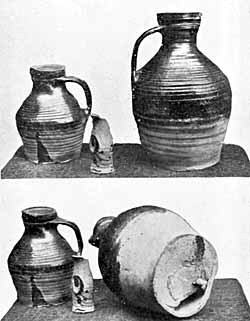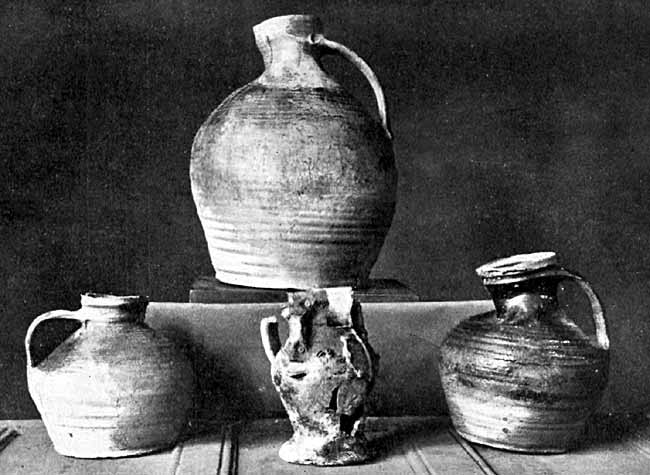In support of Professor Jewitt's evidence, I venture to add a theory which may assist in ascertaining the period of its manufacture. On his journey to York after Hastings, the Norman William, passing through Nottingham, quickly discovered its possibilities as a settlement, with its rock fortress, its broad river on the south, and the forest of Sherwood extending many miles northward. The Saxons and Danes had settled down amicably together, forgetting their fierce strife of two centuries before, but for a long time they continued on such terms of enmity with the Norman invaders, that it was mutually agreed to build a division wall in the town, which extended down what is now Mansfield Road to the river Trent. This wall was built in 1090. The Normans agreed to occupy the western side of this wall, and the Saxons and the Danes the eastern. The pottery was found on the eastern side, close to the wall, and was probably made shortly before the Normans settled themselves on the western side. Now, as has been stated, the Saxons had an antipathy to earthenware for culinary and drinking utensils; so it seems fair to suppose that the kiln, being of no value to them, would be neglected and forgotten. The period of the kiln assumed to be Anglo-Norman, the date, supposing this theory to be feasible, would probably be about 1090. The fact that William the Conqueror attached great importance to Nottingham is shown by his having, in 1068, built a Castle there, and also given a large quantity of land to his son, William Peverel, who founded the adjacent priory of Lenton. Nottingham was an important borough at the time of the compilation of the Domesday Book in 1086.
One is naturally led to wonder under what circumstances a valuable kiln should be abandoned and forgotten, and the above is given as a probable reason.
The local administration and government of the rival colonies were quite distinct, and the arrangement was not finally set aside until 1714. It took 300 years to permanently settle the differences between the Saxons and the Normans.
[In the foregoing paper Mr. R. A. Wilde has apparently adopted the assertion made by the late Mr. T. C. Hine, in his history of Nottingham Castle, that in 1090 the town was divided into two boroughs by a wall running north and south, commencing at the north or Mansfield Road end of Milton Street, taking the direction of Clumber Street, Drury Hill, and Sussex Street, and terminating in the Meadows. The existence of this division wall is not, however, generally accepted by authorities on the history of the town.—Joint Editors.]

Besides the samples of pottery alluded to in the foregoing paper by Mr. Wilde, we have, by the kindness of Mr. C. B. Wright, been permitted to inspect and photograph1 some of the specimens which he still retains in his own possession, and which were all found by him in and around the kilns, revealed by the cutting, near the new railway station. The late Mr. James Shipman, F.G.S., in his little book on "The Old Town Wall of Nottingham," assigns a probable date for this old green glazed ware sometime between the years 1200 and 1500. Mr. R. L. Hobson, of the department of British and Mediaeval Antiquities, at the British Museum, judges from the photographs of these vessels, which have been submitted to him, that they belong to the 14th and 15th centuries; he does not think they are earlier, and is quite sure they are not later; he considers the collection a most interesting one, and one or two of the pieces quite remarkable.
The tall jug is a grand specimen, and does great credit to Mr. Wright's patience and ingenuity, for it was pieced together and built up from many fragments. It stands twenty inches high, and is twenty-five inches in girth at its widest part; the colour is greenish-yellow; the bottom part is unglazed, and what stands for the beard below the face or mask is orange, and the coils, which ornament the body of the jug, are of chocolate-brown.
In the plate that shows a group of four vessels, the largest, which was evidently distorted in the process of making, is also twenty inches high, and measures forty-seven inches round, with a mouth of four and three-quarter inches in diameter; it is of red clay, glazed green at the top and left in its natural state beneath. The jug in the centre is very imperfect, but interesting as being charged with various devices; it is of an olive-green hue, fourteen inches high by twenty inches in circumference. The jug with the distorted neck is evidently a "waster."

POTTERY FOUND IN NOTTINGHAM.
In the picture containing a group of some six vessels, it will be noticed that many are ornamented with scrolls and badges; the small jug at the end of the line having no fewer than eleven devices, similar to those on its larger neighbour, the former being olive-green in colour and the latter yellowish green. The tapering jug in the centre has raised scroll work upon it, not however an inscription—it is of a reddish yellow colour with blends of green.
The colours of these jugs are very fine, and have a pleasing effect when the vessels are grouped together, rendering this collection of pottery, formed by the crude methods of our ancestors, as attractive as it is interesting.
J. Standish, G. Fellows,
Joint editors.

(1) The pictures are from photographs kindly taken for the Society by Mr. E. W. Enfield, J.P.
